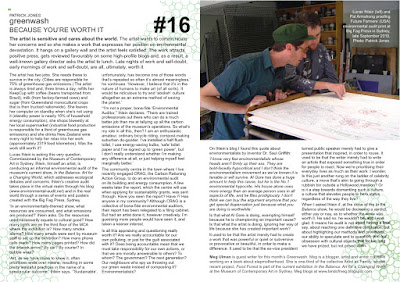
Here’s a curiosity. The above image is a rather blurry photograph I took in the MCA gallery, showing the title wall label for Raquel Ormella‘s artwork in the In the Balance exhibition.
The work, entitled “Poster Reduction”, consists of an electronic whiteboard with two marker-pen drawings: on one side, a majestic Tasmanian tree in the forest, and on the other, a depiction of the offices of The Wilderness Society (the nerve centre of that organisation’s campaign to save the forest). Gallery visitors can view each image in rotation, by pressing a button on the whiteboard control panel.
Here’s Glenn the curator pressing the button:


The other thing that the whiteboard does is to produce “thermal fax paper” type print-outs of the image on the whiteboard. By what miraculous scanning process this works, I am not sure, but it’s pretty cool.
This work has been exhibited elsewhere (notably, at The Performance Space in 2005), and in its previous manifestations, it spat out lots of this thermal paper, which built up in a nice dishevelled pile underneath the whiteboard.
At the MCA version, however, gallery visitors are invited to make a print-out for themselves, by pressing the “print” button on the whiteboard control panel. On the sign adjacent to the whiteboard, the finitude of this paper resource is foregrounded:

As I understand it, this message is partly designed to make visitors “think twice” – do they really need a paper print-out? There’s an ethics of action invoked here – “if I print out a page for myself, that’s one less page available for someone else” and so on… And also a connection between the subject matter of the artwork (the finitude of the forests) and the materiality of the artwork (paper being made out of wood etc)…
But on the day that I tried to print – a few weeks ago – the fax paper was already finished.
Here’s Glenn, having tried to print himself a page, indicating that the paper has run out:

In fact, Isabel the curatorial assistant informed me that it ran out very quickly (within a week or so of the exhibition opening). However the latest news indicates that the MCA is – shock horror! – considering popping in a fresh roll of fax paper…
While this hot controversy has been brewing, Raquel has been out of town – exhibiting in Japan and Melbourne – and she’s just returned. Glenn, the curator, has also been away – in Korea doing research for an exhibition next year – and he also has just returned to Sydney.
Last Thursday in the gallery, they both visited my audit office. They asked me to make space here on the Audit blog for a discussion about this aspect of Raquel’s work. It seems that the two are not, shall we say, in perfect alignment vis-a-vis the title text describing the issue of the purported finitude of the fax paper.
So here it is.
I’ll say no more, but allow our two protagonists to debate it out in the comments below. Keep it clean, team!













